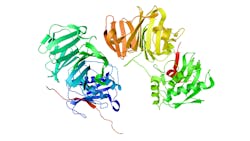Collagenase as a molecular link between oral and systemic disease
What you'll learn in this article
-
How collagenases (MMPs) drive periodontal tissue breakdown and influence oral disease progression
-
The systemic impact of collagenase dysregulation on cardiovascular, metabolic, and neurological health
-
Emerging strategies to monitor and modulate MMP activity for both oral and overall health benefits
Matrix metalloproteinases (MMPs), particularly collagenases, are central to understanding the connection between oral and systemic disease. Collagenase enzymes degrade extracellular matrix (ECM) proteins, including various types of collagens important for structural integrity across oral tissues. As regulators of connective tissue remodeling, their dysregulation leads to tissue breakdown, inflammation, and disease progression not only in the periodontium but also systemically in the cardiovascular, metabolic, and neurological systems.
Collagen—the main structural protein in connective tissue—is found throughout the oral cavity, including the gingival lamina propria, periodontal ligament (PDL), cementum, and alveolar bone matrix. Collagen is absent in the epithelial layer itself but is vital in the underlying supportive tissues. During periodontal disease, microbial colonization and host immune responses upregulate MMPs, leading to collagen degradation, pocket formation, and bone loss. Among the collagenases, MMP-8 (neutrophil collagenase) and MMP-1 (interstitial collagenase) are well studied for their role in degrading types I and III collagen, while MMP-13 targets type II collagen in cartilage and plays a role in advanced periodontal destruction.1
Periodontal pathogens such as Porphyromonas gingivalis (Pg), Tannerella forsythia (Tf), Treponema denticola (Td), and Fusobacterium nucleatum (Fn) amplify collagenase activity. These microbes release their own proteolytic enzymes, including gingipains (Pg) and dentilisin (Td), which not only break down collagen but also disrupt tissue inhibitors of metalloproteinases (TIMPs), compounding host MMP activity.2,3
Proteolytic enzymes are special proteins that break down other proteins into smaller parts, such as peptides or amino acids—think of them as scissors for proteins. While helpful for digestion and tissue repair, they can become harmful when overproduced or dysregulated. This microbial-host synergy in collagen degradation is a key mechanism in the connective tissue breakdown characteristic of periodontitis.
MMP-9, a gelatinase secreted by neutrophils and macrophages, plays a dual role in both periodontal disease and orthodontic tooth movement. In orthodontics, mechanical forces applied to the PDL stimulate inflammatory cytokines (e.g., IL-1, TNF-), which increase MMP-9 expression and initiate extracellular matrix remodeling (ECM).4,5 ECM is a process of breaking down and rebuilding the structural scaffold that supports cells in tissues. Elevated MMP-9 in gingival crevicular fluid (GCF) correlates with active tissue remodeling and can be used as a biomarker for treatment efficacy.6
Host-derived MMP-8 is similarly elevated during active periodontal inflammation. Its upregulation is closely associated with clinical markers of tissue destruction and attachment loss.7 Collagenase activity is now recognized as both a driver and a marker of periodontal disease severity, and its inhibition is a promising therapeutic target.
Collagenase activity and systemic health
The implications of collagenase activity extend well beyond the oral cavity and play a significant role in systemic diseases such as cardiovascular disease (CVD). MMP-7 and MMP-9 are involved in the degradation of extracellular matrix components within atherosclerotic plaques. Their overexpression contributes to plaque instability and rupture, which can precipitate acute cardiovascular events such as myocardial infarction or stroke.
In addition to plaque vulnerability, MMP activity within vascular tissue promotes endothelial dysfunction, inflammation, and pathological vascular remodeling, all of which worsen hypertension and increase ischemic risk.8,9 MMP-8 levels have been detected in serum and are associated with subclinical atherosclerosis. Importantly, MMP-8 has also emerged as a predictive biomarker for cardiovascular mortality, holding clinical significance in early detection and risk stratification of CVD.10-12
In diabetes, chronic hyperglycemia and oxidative stress upregulate MMP-9, contributing to impaired wound healing, extracellular matrix degradation, and the progression of microvascular complications such as retinopathy and nephropathy. This enzymatic imbalance disrupts tissue repair and promotes chronic inflammation.
The bidirectional relationship between diabetes and periodontitis clearly illustrates the systemic consequences of collagenase dysregulation. Elevated MMP activity not only accelerates periodontal tissue destruction but may also impair glycemic control, fueling a self-perpetuating cycle of inflammation and progressive tissue damage.12
Elevated levels of MMP-2 and MMP-9 have been implicated in the pathogenesis of Alzheimer’s disease (AD).13 These enzymes, while essential for normal ECM turnover, become harmful when overexpressed, as they degrade components of the blood-brain barrier (BBB), promote neuroinflammation, and facilitate neuronal damage. Pg has been shown to stimulate MMP production through inflammatory signaling cascades and its DNA, lipopolysaccharide (LPS), and gingipain proteases have been detected in the brains of AD patients, suggesting that chronic periodontal infection may contribute to neurodegenerative processes.
These bacterial components may enter the brain via a compromised BBB or through the trigeminal nerve, triggering glial activation and cytokine release that further elevate MMP expression, exacerbate amyloid-beta accumulation, and promote tau pathology—hallmarks of AD.13,14
Given their pathogenic significance, collagenases—particularly MMPs—are increasingly targeted in both diagnostic and therapeutic strategies. One established intervention is subantimicrobial dose doxycycline (SDD), which selectively inhibits MMP activity without exerting antibacterial pressure and is FDA-approved for managing chronic periodontitis.15 Several nutraceuticals have shown promise in modulating MMP expression and activity. Curcumin can significantly suppress MMP-8 and MMP-13 expression in Pg-induced periodontitis models.16 Epigallocatechin gallate (EGCG), the primary polyphenol in green tea, inhibits MMP-9 activity and suppresses osteoclastogenesis.17,18 Other bioactive compounds offer similar benefits: omega-3 fatty acids lower MMP expression through anti-inflammatory resolvins, resveratrol inhibits NF-B signaling (the master switch telling cells to fight back), leading to downregulation of MMP-2 and MMP-9, and vitamin D modulates immune function and has been shown to reduce MMP-9 expression in inflamed tissues.19
Collagenases serve as molecular bridges linking oral inflammation with systemic pathologies. Their role in ECM degradation, immune modulation, and disease propagation supports the integration of oral diagnostics into broader health monitoring systems. Strategies targeting MMP regulation offer not only periodontal benefit but also systemic protection, reaffirming the interconnectedness of oral and overall health.
Editor's note: This article appeared in the October 2025 print edition of RDH magazine. Dental hygienists in North America are eligible for a complimentary print subscription. Sign up here.
References
- Bildt MM, Bloemen M, Kuijpers-Jagtman AM, Von den Hoff JW. Matrix metalloproteinases and tissue inhibitors of metalloproteinases in gingival crevicular fluid during orthodontic tooth movement. Eur J Orthod. 2009;31(5):529-535. doi:10.1093/ejo/cjn127
- DeCarlo AA Jr, Windsor LJ, Bodden MK, et al. Activation and novel processing of matrix metalloproteinases by a thiol-proteinase from the oral anaerobe Porphyromonas gingivalis. J Dent Res. 1997;76(6):1260-1270. doi:10.1177/00220345970760060501
- Han YW, Wang X. Mobile microbiome: oral bacteria in extra-oral infections and inflammation. J Dent Res. 2013;92(6):485-491. doi:10.1177/0022034513487559
- Şurlin P, Rauten AM, Pirici D, et al. Collagen IV and MMP-9 expression in hypertrophic gingiva during orthodontic treatment. Rom J Morphol Embryol. 2012;53(1):161-165.
- Alhadlaq AM. Biomarkers of orthodontic tooth movement in gingival crevicular fluid: a systematic review. J Contemp Dent Pract. 2015;16(7):578-587. doi:10.5005/jp-journals-10024-1725
- Grant M, Wilson J, Rock P, Chapple I. Induction of cytokines, MMP9, TIMPs, RANKL and OPG during orthodontic tooth movement. Eur J Orthod. 2013;35(5):644-651. doi:10.1093/ejo/cjs057
- Nędzi-Góra M, Górska R, Kostrzewa-Janicka J, Kowalski J. Concentration of MMP-8 and IL-1 in gingival crevicular fluid in patients with chronic and aggressive periodontitis. Cent Eur J Immunol. 2017;42(4):342-346. doi:10.5114/ceji.2017.72824
- Li T, Li X, Feng Y, et al. The role of matrix metalloproteinase-9 in atherosclerotic plaque instability. Mediators Inflamm. 2020;2020:3872367. doi:10.1155/2020/3872367
- Olejarz W, Łacheta D, Kubiak-Tomaszewska G. Matrix metalloproteinases as biomarkers of atherosclerotic plaque instability. Int J Mol Sci. 2020;21(11):3946. doi:10.3390/ijms21113946
- Kormi I, Nieminen MT, Havulinna AS, et al. Matrix metalloproteinase-8 and tissue inhibitor of matrix metalloproteinase-1 predict incident cardiovascular disease events and all-cause mortality in a population-based cohort. Eur J Prev Cardiol. 2017;24(11):1136-1144. doi:10.1177/2047487317706585
- Tuomainen AM, Nyyssönen K, Laukkanen JA, et al. Serum matrix metalloproteinase8 concentrations are associated with cardiovascular outcome in men. Arterioscler Thromb Vasc Biol. 2007;27(12):2722‑2728. doi:10.1161/ATVBAHA.107.154831
- Preshaw PM, Alba AL, Herrera D, et al. Periodontitis and diabetes: a two-way relationship. Diabetologia. 2012;55(1):21-31. doi:10.1007/s00125-011-2342-y
- Dominy SS, Lynch C, Ermini F, et al. Porphyromonas gingivalis in Alzheimer’s disease brains: evidence for disease causation and treatment with small-molecule inhibitors. Sci Adv. 2019;5(1):eaau3333. doi:10.1126/sciadv.aau3333
- Behl T, Kaur G, Sehgal A, et al. Multifaceted role of matrix metalloproteinases in neurodegenerative diseases. Int J Mol Sci. 2021;22(3):1413. doi:10.3390/ijms22031413
- Caton J, Ryan ME. Clinical studies on the management of periodontal diseases utilizing subantimicrobial dose doxycycline (SDD). Pharmacol Res. 2011;63(2):114-120. doi:10.1016/j.phrs.2010.12.003
- Eka Fitria A, Sudiana IK, Soetjipto M. The effect of 1% curcumin methanolic extract on the expression of matrix metalloproteinase‑1, ‑8, and ‑13 in the gingiva of Wistar rats exposed to Porphyromonas gingivalis. J Int Dent Med Res. 2024;17(2):628-634. doi:10.3955/jidmr.2024.628
- Rani Safitri C, Sidharta W, Kusumaningsih A, et al. The effect of curcumin 1% methanolic extract on the expression of matrix metalloproteinase-1, matrix metalloproteinase-8, matrix metalloproteinase-13, neutrophil, macrophage, lymphocyte counts in Porphyromonas gingivalis induced periodontitis: a randomized controlled trial. Saudi Dent J. 2024;36(10):1339-1343. doi:10.1016/j.sdentj.2024.08.002
- Yun JH, Pang EK, Kim CS, et al. Inhibitory effects of green tea polyphenol (-)-epigallocatechin gallate on the expression of matrix metalloproteinase-9 and on the formation of osteoclasts. J Periodontal Res. 2004;39(5):300-307. doi:10.1111/j.1600-0765.2004.00743.x
- Amar S, Zhou Q, Shaik-Dasthagirisaheb Y, Leeman S. Diet-induced obesity in mice causes changes in immune responses and bone loss manifested by bacterial challenge. Proc Natl Acad Sci U S A. 2007;104(13):5137–5142. doi:10.1073/pnas.0611180104
About the Author

Anne O. Rice, BS, RDH, CDP, FAAOSH
Anne O. Rice, BS, RDH, CDP, FAAOSH, founded Oral Systemic Seminars after over 35 years of clinical practice and is passionate about educating the community on modifiable risk factors for dementia and their relationship to dentistry. She is a certified dementia practitioner, a longevity specialist, a fellow with AAOSH, and has consulted for Weill Cornell Alzheimer’s Prevention Clinic, FAU, and Atria Institute. Reach out to Anne at anneorice.com.
